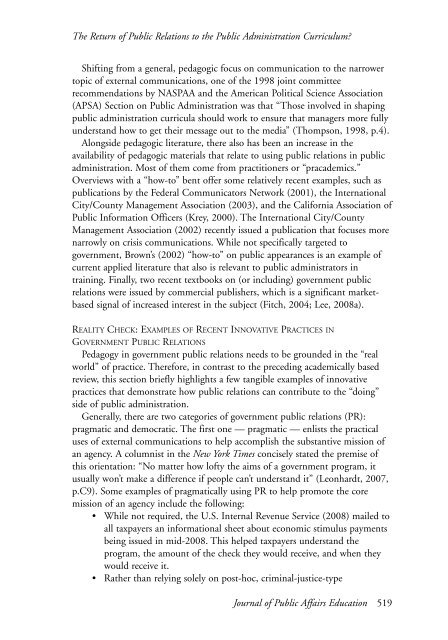JOURNAL OF PUBLIC AFFAIRS EDUCATION - National ...
JOURNAL OF PUBLIC AFFAIRS EDUCATION - National ...
JOURNAL OF PUBLIC AFFAIRS EDUCATION - National ...
Create successful ePaper yourself
Turn your PDF publications into a flip-book with our unique Google optimized e-Paper software.
The Return of Public Relations to the Public Administration Curriculum?<br />
Shifting from a general, pedagogic focus on communication to the narrower<br />
topic of external communications, one of the 1998 joint committee<br />
recommendations by NASPAA and the American Political Science Association<br />
(APSA) Section on Public Administration was that “Those involved in shaping<br />
public administration curricula should work to ensure that managers more fully<br />
understand how to get their message out to the media” (Thompson, 1998, p.4).<br />
Alongside pedagogic literature, there also has been an increase in the<br />
availability of pedagogic materials that relate to using public relations in public<br />
administration. Most of them come from practitioners or “pracademics.”<br />
Overviews with a “how-to” bent offer some relatively recent examples, such as<br />
publications by the Federal Communicators Network (2001), the International<br />
City/County Management Association (2003), and the California Association of<br />
Public Information Officers (Krey, 2000). The International City/County<br />
Management Association (2002) recently issued a publication that focuses more<br />
narrowly on crisis communications. While not specifically targeted to<br />
government, Brown’s (2002) “how-to” on public appearances is an example of<br />
current applied literature that also is relevant to public administrators in<br />
training. Finally, two recent textbooks on (or including) government public<br />
relations were issued by commercial publishers, which is a significant marketbased<br />
signal of increased interest in the subject (Fitch, 2004; Lee, 2008a).<br />
REALITY CHECK: EXAMPLES <strong>OF</strong> RECENT INNOVATIVE PRACTICES IN<br />
GOVERNMENT <strong>PUBLIC</strong> RELATIONS<br />
Pedagogy in government public relations needs to be grounded in the “real<br />
world” of practice. Therefore, in contrast to the preceding academically based<br />
review, this section briefly highlights a few tangible examples of innovative<br />
practices that demonstrate how public relations can contribute to the “doing”<br />
side of public administration.<br />
Generally, there are two categories of government public relations (PR):<br />
pragmatic and democratic. The first one — pragmatic — enlists the practical<br />
uses of external communications to help accomplish the substantive mission of<br />
an agency. A columnist in the New York Times concisely stated the premise of<br />
this orientation: “No matter how lofty the aims of a government program, it<br />
usually won’t make a difference if people can’t understand it” (Leonhardt, 2007,<br />
p.C9). Some examples of pragmatically using PR to help promote the core<br />
mission of an agency include the following:<br />
• While not required, the U.S. Internal Revenue Service (2008) mailed to<br />
all taxpayers an informational sheet about economic stimulus payments<br />
being issued in mid-2008. This helped taxpayers understand the<br />
program, the amount of the check they would receive, and when they<br />
would receive it.<br />
• Rather than relying solely on post-hoc, criminal-justice-type<br />
Journal of Public Affairs Education 519

















